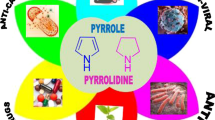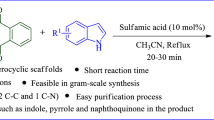Abstract
A design toward C–C bonded 2,6-bis(1H-1,2,3-triazol-4-yl)-9H-purine and 2-piperidinyl-6-(1H-1,2,3-triazol-4-yl)-9H-purine derivatives was established using the combination of Mitsunobu, Sonogashira, copper (I) catalyzed azide-alkyne cycloaddition, and SNAr reactions. 11 examples of 2,6-bistriazolylpurine and 14 examples of 2-piperidinyl-6-triazolylpurine intermediates were obtained, in 38–86% and 41–89% yields, respectively. Obtained triazole-purine conjugates expressed good fluorescent properties which were studied in the solution and in the thin layer film for the first time. Quantum yields reached up to 49% in DMSO for bistriazolylpurines and up to 81% in DCM and up to 95% in DMSO for monotriazolylpurines. Performed biological studies in mouse embryo fibroblast, human keratinocyte, and transgenic adenocarcinoma of the mouse prostate cell lines showed that most of obtained triazole-purine conjugates are not cytotoxic. The 50% cytotoxic concentration of the tested derivatives was in the range from 59.6 to 1528.7 µM.
Graphical Abstract






Similar content being viewed by others
Availability of Data and Materials
Below is the link to the electronic supporting information.
References
Sonogashira K, Tohda Y, Hagihara N (1975) A convenient synthesis of acetylenes: catalytic substitutions of acetylenic hydrogen with bromoalkenes, iodoarenes and bromopyridines. Tetrahedron Lett 16:4467–4470. https://doi.org/10.1016/S0040-4039(00)91094-3
Chinchilla R, Nájera C (2007) The Sonogashira reaction: A booming methodology in synthetic organic chemistry. Chem Rev 107:874–922. https://doi.org/10.1021/cr050992x
Biffis A, Centomo P, Del Zotto A, Zecca M (2018) Pd Metal catalysts for cross-couplings and related reactions in the 21st century: A critical review. Chem Rev 118:2249–2295. https://doi.org/10.1021/acs.chemrev.7b00443
Johansson Seechurn CCC, Kitching MO, Colacot TJ, Snieckus V (2012) Palladium-catalyzed cross-coupling: A historical contextual perspective to the 2010 nobel prize. Angew Chemie - Int Ed 51:5062–5085. https://doi.org/10.1002/anie.201107017
Bag SS, Jana S, Kasula M (2018) Sonogashira cross-coupling: Alkyne-modified nucleosides and their applications. Elsevier Inc
Hocek M (2003) Syntheses of purines bearing carbon substituents in positions 2, 6 or 8 by metal- or organometal-mediated C−C bond-forming reactions. Eur J Org Chem 2003:245–254. https://doi.org/10.1002/ejoc.200390025
Agrofoglio LA, Gillaizeau I, Saito Y (2003) Palladium-assisted routes to nucleosides. Chem Rev 103:1875–1916. https://doi.org/10.1021/cr010374q
Manvar A, Shah A (2013) Microwave-assisted chemistry of purines and xanthines. An overview Dedicated to the late Professor V.M. Thakor on his 94th birthday. Tetrahedron 69:8105–8127. https://doi.org/10.1016/j.tet.2013.06.034
Fang X, Gao Q, Zhang W et al (2020) Multisensing emissive 8-phenylethynylated 2′-deoxyadenosines and 2′-deoxyisoguanosines. Tetrahedron 76:8–16. https://doi.org/10.1016/j.tet.2019.130795
Ibrahim N, Chevot F, Legraverend M (2011) Regioselective Sonogashira cross-coupling reactions of 6-chloro-2,8-diiodo- 9-THP-9H-purine with alkyne derivatives. Tetrahedron Lett 52:305–307. https://doi.org/10.1016/j.tetlet.2010.11.033
Malthum S, Polkam N, Allaka TR et al (2017) Synthesis, characterization and biological evaluation of purine nucleoside analogues. Tetrahedron Lett 58:4166–4168. https://doi.org/10.1016/j.tetlet.2017.09.041
Bilbao N, Vázquez-González V, Aranda MT, González-Rodríguez D (2015) Synthesis of 5-/8-halogenated or ethynylated lipophilic nucleobases as potential synthetic intermediates for supramolecular chemistry. Eur J Org Chem 2015:7160–7175. https://doi.org/10.1002/ejoc.201501026
Sedláček O, Břehová P, Pohl R et al (2011) The synthesis of the 8-C-substituted 2,6-diamino-9-[2-(phosphonomethoxy)ethyl]purine (PMEDAP) derivatives by diverse cross-coupling reactions. Can J Chem 89:488–498. https://doi.org/10.1139/V11-001
Nagy A, Kotschy A (2008) Synthesis of 6-ethynylpurine derivatives. Tetrahedron Lett 49:3782–3784. https://doi.org/10.1016/j.tetlet.2008.04.011
Křováček M, Dvořáková H, Votruba I et al (2011) 6-Alkynylpurines bearing electronacceptor substituents: Preparation, reactivity in cycloaddition reactions and cytostatic activity. Collect Czechoslov Chem Commun 76:1487–1527. https://doi.org/10.1135/cccc2011176
Buchanan HS, Pauff SM, Kosmidis TD et al (2017) Modular, step-efficient palladium-catalyzed cross-coupling strategy to access C6-heteroaryl 2-aminopurine ribonucleosides. Org Lett 19:3759–3762. https://doi.org/10.1021/acs.orglett.7b01602
Mathew SC, By Y, Berthault A et al (2010) Expeditious synthesis and biological evaluation of new C-6 1,2,3-triazole adenosine derivatives A1 receptor antagonists or agonists. Org Biomol Chem 8:3874–3881. https://doi.org/10.1039/c0ob00017e
Cosyn L, Palaniappan KK, Kim S-K et al (2006) 2-triazole-substituted adenosines: a new class of selective A3 adenosine receptor agonists, partial agonists, and antagonists. J Med Chem 49:7373–7383. https://doi.org/10.1021/jm0608208
Tosh DK, Chinn M, Yoo LS et al (2010) 2-Dialkynyl derivatives of (N)-methanocarba nucleosides: “Clickable” A3 adenosine receptor-selective agonists. Bioorganic Med Chem 18:508–517. https://doi.org/10.1016/j.bmc.2009.12.018
Luan F, Melo A, Borges F, Cordeiro MNDS (2011) Affinity prediction on A3 adenosine receptor antagonists: The chemometric approach. Bioorganic Med Chem 19:6853–6859. https://doi.org/10.1016/j.bmc.2011.09.032
Matsuda a, Shinozaki M, Yamaguchi T, et al (1992) Nucleosides and nucleotides. 103. 2-Alkynyladenosines: a novel class of selective adenosine A2 receptor agonists with potent antihypertensive effects. J Med Chem 35:241–252
Sági G, Ötvös L, Ikeda S et al (1994) Synthesis and antiviral activities of 8-alkynyl-, 8-alkenyl-, and 8-alkyl-2′-deoxyadenosine analogs. J Med Chem 37:1307–1311. https://doi.org/10.1021/jm00035a010
He X, Kuang S, Gao Q et al (2022) Bright fluorescent purine analogues as promising probes. Nucleosides Nucleotides Nucleic Acids 41:45–60. https://doi.org/10.1080/15257770.2021.2004418
Okamura H, Trinh GH, Dong Z et al (2022) Selective and stable base pairing by alkynylated nucleosides featuring a spatially-separated recognition interface. Nucleic Acids Res 50:3042–3055. https://doi.org/10.1093/nar/gkac140
Da XC, He ZY, Guo CX et al (2020) Conformation of G-quadruplex controlled by click reaction. Molecules 25:1–8. https://doi.org/10.3390/molecules25184339
Creech C, Kanaujia M, Causey CP (2015) Synthesis and evaluation of 2-ethynyl-adenosine-5′-triphosphate as a chemical reporter for protein AMPylation. Org Biomol Chem 13:8550–8555. https://doi.org/10.1039/c5ob01081k
Kele P, Li X, Link M et al (2009) Clickable fluorophores for biological labeling - with or without copper. Org Biomol Chem 7:3486–3490. https://doi.org/10.1039/b907741c
Redwan IN, Bliman D, Tokugawa M et al (2013) Synthesis and photophysical characterization of 1- and 4-(purinyl)triazoles. Tetrahedron 69:8857–8864. https://doi.org/10.1016/j.tet.2013.08.023
Dyrager C, Börjesson K, Dinér P et al (2009) Synthesis and photophysical characterisation of fluorescent 8-(1 H-1,2,3-triazol-4-yl)adenosine derivatives. Eur J Org Chem 1515–1521. https://doi.org/10.1002/ejoc.200900018
Dierckx A, Dinér P, El-Sagheer AH et al (2011) Characterization of photophysical and base-mimicking properties of a novel fluorescent adenine analogue in DNA. Nucleic Acids Res 39:4513–4524. https://doi.org/10.1093/nar/gkr010
O’Mahony G, Ehrman E, Grøtli M (2005) Synthesis of adenosine-based fluorosides containing a novel heterocyclic ring system. Tetrahedron Lett 46:6745–6748. https://doi.org/10.1016/j.tetlet.2005.07.115
Pettersson M, Bliman D, Jacobsson J et al (2015) 8-Triazolylpurines: Towards fluorescent inhibitors of the MDM2/p53 interaction. PLoS ONE 10:1–17. https://doi.org/10.1371/journal.pone.0124423
Kovaļovs A, Novosjolova I, Bizdēna Ē et al (2013) 1,2,3-Triazoles as leaving groups in purine chemistry: a three-step synthesis of N6-substituted-2-triazolyl-adenine nucleosides and photophysical properties thereof. Tetrahedron Lett 54:850–853. https://doi.org/10.1016/j.tetlet.2012.11.095
Šišuļins A, Bucevičius J, Tseng Y-T et al (2019) Synthesis and fluorescent properties of N(9)-alkylated 2-amino-6-triazolylpurines and 7-deazapurines. Beilstein J Org Chem 15:474–489. https://doi.org/10.3762/bjoc.15.41
Jovaisaite J, Cīrule D, Jeminejs A et al (2020) Proof of principle of a purine D-A-D′ ligand based ratiometric chemical sensor harnessing complexation induced intermolecular PET. Phys Chem Chem Phys 22:26502–26508. https://doi.org/10.1039/d0cp04091f
Sebris A, Traskovskis K, Novosjolova I, Turks M (2021) Synthesis and photophysical properties of 2-azolyl-6-piperidinylpurines. Chem Heterocycl Compd 57:560–567. https://doi.org/10.1007/s10593-021-02943-1
Sebris A, Novosjolova I, Traskovskis K et al (2022) Photophysical and electrical properties of highly luminescent 2/6-triazolyl-substituted push-pull purines. ACS Omega 7:5242–5253. https://doi.org/10.1021/acsomega.1c06359
Novosjolova I, Bizdēna Ē, Turks M (2013) Application of 2,6-diazidopurine derivatives in the synthesis of thiopurine nucleosides. Tetrahedron Lett 54:6557–6561. https://doi.org/10.1016/j.tetlet.2013.09.095
Cīrule D, Novosjolova I, Bizdēna Ē, Turks M (2021) 1,2,3-Triazoles as leaving groups: SNAr reactions of 2,6-bistriazolylpurines with O- and C-nucleophiles. Beilstein J Org Chem 17:410–419. https://doi.org/10.3762/bjoc.17.37
Kriķis KE, Novosjolova I, Mishnev A, Turks M (2021) 1,2,3-Triazoles as leaving groups in SNAr-Arbuzov reactions: Synthesis of C6-phosphonated purine derivatives. Beilstein J Org Chem 17:193–202. https://doi.org/10.3762/BJOC.17.19
Kapilinskis Z, Novosjolova I, Turks M (2018) Purine-furan and purine-thiophene conjugates. Molbank. https://doi.org/10.3390/M1024
Kim HS, Barak D, Harden TK et al (2001) Acyclic and cyclopropyl analogues of adenosine bisphosphate antagonists of the P2Y1 receptor: Structure-activity relationships and receptor docking. J Med Chem 44:3092–3108. https://doi.org/10.1021/jm010082h
Lv J, Luo T, Zou D, Dong H (2019) Using DMF as both a catalyst and cosolvent for the regioselective silylation of polyols and diols. Eur J Org Chem 2019:6383–6395. https://doi.org/10.1002/ejoc.201901195
Hellerman L (1927) The preparation of β-triphenylethylamine. Rearrangement of β-triphenylpropionhydroxamic acid. J Am Chem Soc 49:1735–1742. https://doi.org/10.1021/ja01406a013
Traskovskis K, Mihailovs I, Tokmakovs A et al (2012) Triphenyl moieties as building blocks for obtaining molecular glasses with nonlinear optical activity. J Mater Chem 22:11268–11276. https://doi.org/10.1039/c2jm30861d
Traskovskis K, Ruduss A, Kokars V et al (2019) Thiphenylmethane based structural fragments as building blocks towards solution-processable heteroleptic iridium(III) complexes for OLED use. New J Chem 43:37–47. https://doi.org/10.1039/c8nj04484h
Glaser C (1869) Beitrage zur Kenntnifs des Acetenylbenzols. Ber Dtsch Chem Ges 2:422–424
Glaser C (1870) Untersuchungen über einige Derivate der Zimmtsäure. Justus Liebigs Ann Chem 154:137–171. https://doi.org/10.1002/jlac.18701540202
Sindhu KS, Anilkumar G (2014) Recent advances and applications of Glaser coupling employing greener protocols. RSC Adv 4:27867–27887. https://doi.org/10.1039/c4ra02416h
Alvarez SG, Alvarez MT (1997) A Practical procedure for the synthesis of alkyl azides at ambient temperature in dimethyl sulfoxide in high purity and yield. Synthesis (Stuttg) 1997:413–414. https://doi.org/10.1055/s-1997-1206
Barral K, Moorhouse AD, Moses JE (2007) Efficient conversion of aromatic amines into azides: A one-pot synthesis of triazole linkages. Org Lett 9:1809–1811. https://doi.org/10.1021/ol070527h
Zhang D, Fan Y, Yan Z et al (2019) Reactions of α-haloacroleins with azides: Highly regioselective synthesis of formyl triazoles. Green Chem 21:4211–4216. https://doi.org/10.1039/c9gc01129c
Vereshchagin LI, Kizhnyaev VN, Verkhozina ON et al (2004) Synthesis of polycyclic functionally-substituted triazole- and tetrazole-containing systems. Russ J Org Chem 40:1156–1161. https://doi.org/10.1023/B:RUJO.0000045898.10072.7f
Schmitz J, Li T, Bartz U, Gütschow M (2016) Cathepsin B inhibitors: combining dipeptide nitriles with an occluding loop recognition element by click chemistry. ACS Med Chem Lett 7:211–216. https://doi.org/10.1021/acsmedchemlett.5b00474
Schulz A, Thomas M, Villinger A (2019) Tetrazastannoles versus distannadiazanes-a question of the tin(ii) source. Dalt Trans 48:125–132. https://doi.org/10.1039/C8DT04295K
Gribanov PS, Topchiy MA, Golenko YD et al (2016) An unprecedentedly simple method of synthesis of aryl azides and 3-hydroxytriazenes. Green Chem 18:5984–5988. https://doi.org/10.1039/c6gc02379g
Verkhozina ON, Kizhnyaev VN, Vereshchagin LI et al (2003) Synthesis of polynuclear nonfused azoles. Russ J Org Chem 39:1792–1796. https://doi.org/10.1023/B:RUJO.0000019746.10504.f3
Acknowledgements
The authors thank the Latvia-Lithuania-Taiwan joint grant “Molecular Electronics in functionalized Purines: fundamental Study and applications (MEPS)” for financial support and Dr. chem. Kristine Lazdoviča for IR analysis. A.B. thanks the European Social Fund within Project No. 8.2.2.0/20/I/008 “Strengthening of PhD students and academic personnel of Riga Technical University and BA School of Business and Finance in the strategic fields of specialization”.
Funding
The Latvia-Lithuania-Taiwan joint grant “Molecular Electronics in functionalized Purines: fundamental Study and applications (MEPS)”. The European Social Fund within Project No. 8.2.2.0/20/I/008.
Author information
Authors and Affiliations
Contributions
M.T. and I.N. contributed to the study conception and design, and supervision. A.B. and A.S. performed the synthesis and analysis of purine derivatives, and wrote the experimental part. K.T., J.J. and S.J. performed the photophysical studies and analysis of data. H.W.C. and H.T.C. performed cytotoxicity experiments and analysis. The first draft of the manuscript was written by I.N. and all authors commented on previous versions of the manuscript. All authors read and approved the final manuscript.
Corresponding author
Ethics declarations
Ethical Approval
Not applicable.
Competing Interests
The authors declare no competing financial or personal interest.
Additional information
Publisher's Note
Springer Nature remains neutral with regard to jurisdictional claims in published maps and institutional affiliations.
Supplementary Information
Below is the link to the electronic supplementary material.
Rights and permissions
Springer Nature or its licensor (e.g. a society or other partner) holds exclusive rights to this article under a publishing agreement with the author(s) or other rightsholder(s); author self-archiving of the accepted manuscript version of this article is solely governed by the terms of such publishing agreement and applicable law.
About this article
Cite this article
Burcevs, A., Sebris, A., Traskovskis, K. et al. Synthesis of Fluorescent C–C Bonded Triazole-Purine Conjugates. J Fluoresc 34, 1091–1097 (2024). https://doi.org/10.1007/s10895-023-03337-6
Received:
Accepted:
Published:
Issue Date:
DOI: https://doi.org/10.1007/s10895-023-03337-6




